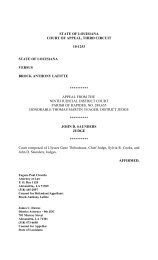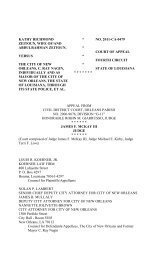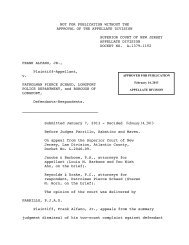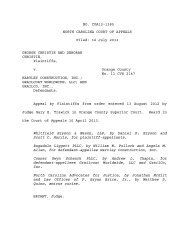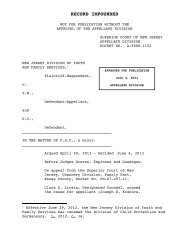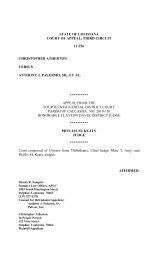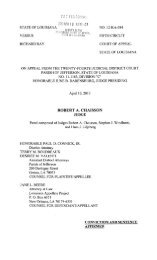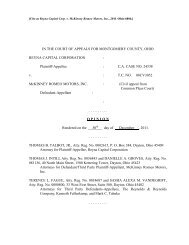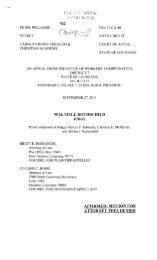state of louisiana court of appeal, third circuit 11-816 timothy bernard ...
state of louisiana court of appeal, third circuit 11-816 timothy bernard ...
state of louisiana court of appeal, third circuit 11-816 timothy bernard ...
Create successful ePaper yourself
Turn your PDF publications into a flip-book with our unique Google optimized e-Paper software.
STATE OF LOUISIANACOURT OF APPEAL, THIRD CIRCUIT<strong>11</strong>-<strong>816</strong>TIMOTHY BERNARD, SR., ET UXVERSUSLAFAYETTE CITY-PARISH CONSOLIDATED GOVERNMENT, ET AL.**********APPEAL FROM THEFIFTEENTH JUDICIAL DISTRICT COURTPARISH OF LAFAYETTE, NO. C-2010-7124HONORABLE MARILYN CARR CASTLE, DISTRICT JUDGE**********ULYSSES GENE THIBODEAUXCHIEF JUDGE**********Court composed <strong>of</strong> Ulysses Gene Thibodeaux, Chief Judge, Jimmie C. Peters, andBilly Howard Ezell, Judges.REVERSED AND REMANDED.F. Douglas WimberlyCloyd, Wimberly & Villemarette, L.L.C.P. O. Box 53951Lafayette, LA 70505-3951Telephone: (337) 289-6906COUNSEL FOR:Defendants/Appellees - Lafayette City-Parish Consolidated Governmentand Thomas R. CarrollTimothy Bernard, Sr.In Proper Person1224 Carmel DriveLafayette, LA 70501Telephone: (337) 212-1094
THIBODEAUX, Chief Judge.The plaintiffs, Timothy Bernard Sr., his wife, Sheman Bernard, andhis mother, Evelyn Bernard (the Bernards), <strong>appeal</strong> a judgment dismissing their suitagainst the defendants, Lafayette City-Parish Consolidated Government throughThomas R. Carroll III, Joey Durel, and the Public Works Department (LCG).Following a pre-trial hearing on LCG‟s exception <strong>of</strong> prescription, the trial <strong>court</strong>found that the Bernards‟ action prescribed one year after the LCG completed itsdrainage project adjacent to the Bernards‟ property.Finding that the damages claimed by the Bernards are subject to atwo-year prescriptive period and that they filed suit within the two-year period, wereverse the judgment <strong>of</strong> the trial <strong>court</strong>.I.ISSUEWe must decide whether the trial <strong>court</strong> erred in granting thedefendants‟ exception <strong>of</strong> prescription and dismissing the plaintiffs‟ suit withprejudice.II.FACTS AND PROCEDURAL HISTORYOn October 30, 2008, LCG completed drainage improvementsadjacent to the Bernards‟ property. These improvements allegedly caused erosionand a hazardous sink hole on their property. The date <strong>of</strong> the completion <strong>of</strong> theproject is not in dispute and is supported by the defendants‟ affidavits.On October 29, 2010, the Bernards, who are unrepresented, pro seplaintiffs, due to the withdrawal <strong>of</strong> their former attorney, filed a two-sentence,hand-written petition for $5,000.00 in small claims <strong>court</strong>, alleging: “Damages
caused by wrongful conduct <strong>of</strong> defendants as poor drainage system was installedby defendants herein.” The petition further <strong>state</strong>d that a sink hole was due to thedefendants‟ negligence and mismanagement.LCG transferred the suit to the district <strong>court</strong> and filed an exception <strong>of</strong>prescription, asserting that the Bernards‟ delictual action had a one-yearprescriptive period and had prescribed on October 30, 2009.One month before the hearing on LCG‟s exception <strong>of</strong> prescription, theBernards filed a letter with the Clerk <strong>of</strong> Court, requesting a hearing on theprescriptive period.They cited La.R.S. 19:102 and 19:103 and quoted thelanguage providing for a two-year prescriptive period on claims for damagescaused by a procedural expropriation <strong>of</strong> property through petition and hearing.At the hearing on the exception, the trial judge told the Bernards thatthey would have to provide evidence <strong>of</strong> an expropriation proceeding in order toavail themselves <strong>of</strong> the two-year prescriptive period. She directed them to thepublic records at City Hall and gave them ten days to obtain the evidence. Theonly “evidence” that the Bernards produced was a letter from their former attorney,dated October 18, 2010, signifying that he had returned their client file and advisedthem that they must file suit against the LCG before October 30, 2010. The letteritself did not mention expropriation or any specific cause <strong>of</strong> action, but it led to theBernards‟ filing <strong>of</strong> their petition on October 29, 2010.The trial judge granted the LCG‟s exception <strong>of</strong> prescription anddismissed the Bernards‟ suit with prejudice. The judge inserted a handwrittenrevision in her judgment, stating: “The plaintiffs were afforded additional time toprovide to the <strong>court</strong> evidence to support their claim that their property had beenthe subject <strong>of</strong> expropriation. No such evidence was provided.”The Bernards filed a motion for an <strong>appeal</strong> and for a new trial underLa.Code Civ.P. art. 1971. LCG filed an answer in the district <strong>court</strong> asserting2
frivolous <strong>appeal</strong>. The Bernard‟s motion for <strong>appeal</strong> was granted, but the trial<strong>court</strong>‟s order did not address the request for a new trial. The new trial was,therefore, denied.We now consider whether the Bernards‟ suit against the LCG hadprescribed when they filed it on October 29, 2010.III.STANDARD OF REVIEWAn appellate <strong>court</strong> may not set aside a trial <strong>court</strong>‟s findings <strong>of</strong> fact inthe absence <strong>of</strong> manifest error or unless it is clearly wrong.Stobart v. State,Through DOTD, 617 So.2d 880 (La.1993); Rosell v. ESCO, 549 So.2d 840(La.1989). “Nevertheless, when the <strong>court</strong> <strong>of</strong> <strong>appeal</strong> finds that a reversible error <strong>of</strong>law or manifest error <strong>of</strong> material fact was made in the trial <strong>court</strong>, it is required toredetermine the facts de novo from the entire record and render a judgment on themerits.” Id. at 844, n.2.IV.LAW AND DISCUSSIONThe Bernards contend that the trial <strong>court</strong> erred in granting the LCG‟sexception <strong>of</strong> prescription. We agree. Under the applicable statute, not cited ordiscussed by the parties or the trial judge in this case, the Bernards‟ suit had notprescribed, and we reverse.It is clear from the Bernards‟ efforts at self-representation at thehearing, that their claim was for “damages” caused to their property by publicwork on their property and along their property lines, not for a procedural orstatutory expropriation <strong>of</strong> their property by LCG, which was the only issueaddressed by the trial <strong>court</strong>. The Bernards did not understand expropriation under3
the statutes they cited, La.R.S. 19:102 and 19:103. 1Those statutes are inapplicablein this case because they provide for (1) statutory or procedural expropriation <strong>of</strong>property by municipal corporations; (2) exercised by the filing <strong>of</strong> a petition and ahearing on the petition, which did not occur in this case. There was no proceduralor statutory expropriation by LCG under the cited statutes in this case. The citedstatutes do provide for a two-year prescriptive period if the property owner claimsdamages caused by the expropriation, which was the thrust <strong>of</strong> the Bernard‟sarguments. 2Notwithstanding the mistaken citations, the Bernards articulated at thehearing that LCG had used their property while installing a drainage system andthat the result was damage to their property, unsafe erosion on their property, ahazardous sinkhole that they had to rope <strong>of</strong>f in order to prevent injury to theirchildren and guests, loss <strong>of</strong> enjoyment, and devaluation <strong>of</strong> property.Those damages are covered under La.R.S. 9:5624, which alsoprovides for a two-year prescriptive period: “When private property is damagedfor public purposes any and all actions for such damages are prescribed by theprescription <strong>of</strong> two years, which shall begin to run after the completion andacceptance <strong>of</strong> the public works.” La.R.S. 9:5624. The fact that the Bernards citedthe wrong statute is <strong>of</strong> no moment. “[A] pro se litigant who lacks formal trainingin the law and its rules <strong>of</strong> procedure . . . should be allotted more latitude than thoseplaintiffs represented by counsel.” Brooks v. Tradesmen Int’l, Inc., 03-1871, p. 51“Where a price cannot be agreed upon with the owner, any municipal corporation <strong>of</strong>Louisiana may expropriate property whenever such a course is determined to be necessary forthe public interest by the governing authority <strong>of</strong> the municipality . . . .” La.R.S. 19:102. “Therights <strong>of</strong> expropriation granted in R.S. 19:102 shall be exercised in the following manner: (1) Apetition shall be filed by the plaintiff [municipal corporation] in the district <strong>court</strong> <strong>of</strong> the parish inwhich the property to be expropriated is situated. . . .” La.R.S. 19:103(A). Proceduralrequirements are further detailed in La.R.S. 19:103(A)(2) and (3), including the payment <strong>of</strong>compensation to the owner; and the two-year prescriptive period for an owner‟s damages due tothe procedural expropriation is addressed in La.R.S. 19:103(B).2 In their motion for a new trial and <strong>appeal</strong>, the Bernards cited La.R.S. 19:2, et seq., whichprovides for procedural expropriation as well, by the <strong>state</strong>, its political corporations andsubdivisions, and certain other corporations and limited liability companies, also with a two-yearprescriptive period. However, this set <strong>of</strong> statutes is similarly inapplicable because there was noprocedural expropriation here.4
only to properly pleaded material allegations <strong>of</strong> fact, as opposed to allegationsdeficient in material detail, conclusory factual allegations, or allegations <strong>of</strong> law.”Kirby v. Field, 04-1898, p. 6 (La.App. 1 Cir. 9/23/05), 923 So.2d 131, 135, writdenied, 05-2467 (La. 3/24/06), 925 So.2d 1230 (citations and footnote omitted).In support <strong>of</strong> its exception <strong>of</strong> prescription, LCG provided the trial<strong>court</strong> with three affidavits by the director, associate director, and a supervisor, <strong>of</strong>LCG‟s Department <strong>of</strong> Public Works. The affidavits confirmed that the drainageproject was surveyed and constructed within LCG‟s drainage right <strong>of</strong> way,adjacent to the Bernards‟ property; that the drainage improvements met allapplicable design and operational standards; and, that the project was completed onOctober 30, 2008.The Bernards did not provide affidavits, but Timothy Bernard, Sr. andSheman Bernard appeared pro se in open <strong>court</strong> on the date <strong>of</strong> the pre-trial hearingon prescription and testified on their own behalf. While the transcript <strong>of</strong> thehearing does not indicate a swearing-in <strong>of</strong> the plaintiffs, the <strong>court</strong>‟s minutes <strong>state</strong>that Timothy and Sheman Bernard appeared in “proper person” and that “[o]ralargument and testimony was presented by and between the respective parties.”The trial judge herself questioned the plaintiffs and limited their responses.Both <strong>of</strong> the Bernards attempted to provide a factual background toexplain the nature <strong>of</strong> their claims for damages, and Sheman Bernard, in particular,tried to focus her remarks on evidentiary matters for the <strong>court</strong>. Ms. Bernardexplained to the <strong>court</strong> that they had filed their petition in small claims <strong>court</strong> withinthe two year prescriptive period as advised by their former attorney, and that thepetition was filed “for the damages to be fixed on the property.” The <strong>court</strong>specifically asked Ms. Bernard under what statute she was making her claim, andMs. Bernard found the language <strong>of</strong> La.R.S 19:103 and read it to the <strong>court</strong>. It isunknown why the Bernards chose to cite that statute, as it was not mentioned in the6
letter from the former attorney. Nor was it ever cited or specifically addressed byLCG. It was very clear from the transcript that the Bernards did not understand themeaning <strong>of</strong> expropriation in the legal sense, or have knowledge <strong>of</strong> other statutesthat could address their claims for damages. Once the statute was cited, however,the trial <strong>court</strong> limited their testimony to that statute. Because Louisiana eschewsthe “theory <strong>of</strong> the case” pleading, that procedure was flawed.We note at this juncture that the brief record in this case indicates atwo-year-plus battle between the parties, during which there were complaints <strong>of</strong>flooding and requests for culverts and drainage boxes, alleged property damageduring construction <strong>of</strong> the drainage project, attempts by the Bernards to stop theconstruction, anger, police intervention, arrest, and a failed attempt by LCG to getan injunction against the Bernards to prevent them from filing complaints againstLCG. At the hearing on the exception, the trial <strong>court</strong> asked if there had been anexpropriation proceeding, and it eventually became clear through their efforts toexplain, that the Bernards believed the injunction brought against them by LCG,due to their continuing complaints, was the expropriation proceeding mentioned inthe inapplicable statute, La.R.S. 19:103.The trial judge told the Bernards that expropriation meant that LCGwould have filed a petition for expropriation, taken some <strong>of</strong> their property, andpaid them for it.The <strong>court</strong> continued to ask for pro<strong>of</strong> <strong>of</strong> an expropriationproceeding and a taking, and she told the Bernards that without it, they would besubject to a one-year prescriptive period.This is not an accurate <strong>state</strong>ment <strong>of</strong> the law, as takings occur withoutexpropriation proceedings, and a plaintiff‟s action for such a taking under La.R.S.13:5<strong>11</strong>1, has a three-year prescriptive period. More importantly, as indicatedabove, La.R.S. 9:5624 addresses the very nature <strong>of</strong> damages claimed by theBernards, without a taking, and it has a two-year prescriptive period.7
In Avenal, the Louisiana Supreme Court articulated the distinctionbetween a taking, under La.R.S. 13:5<strong>11</strong>1, and damage to property under La.R.S.9:5624, neither <strong>of</strong> which was considered by the trial judge in her examination <strong>of</strong>the Bernards.[T]he relevant consideration is whether plaintiffs‟property was “taken” for a public purpose, or whether itwas “damaged” for a public purpose. A distinctionbetween a taking and a damaging is necessary because <strong>of</strong>the existence <strong>of</strong> two relevant prescription statutes, La.R.S. 13:5<strong>11</strong>1 and La. R.S. 9:5624. Section 5<strong>11</strong>1 <strong>of</strong> Title13 is entitled “Appropriation <strong>of</strong> property by <strong>state</strong>, parish,municipality or agencies there<strong>of</strong>; attorney, engineeringand appraisal fees; prescription” and provides in pertinentpart: “[A] proceeding brought against the <strong>state</strong> <strong>of</strong>Louisiana . . . or other political subdivision . . ., forcompensation for the taking <strong>of</strong> property by the defendant,other than through an expropriation proceeding, . . . shallprescribe three years from the date <strong>of</strong> such taking.”Section 5624 <strong>of</strong> Title 9 provides: “When privateproperty is damaged for public purposes any and allactions for such damages are prescribed by theprescription <strong>of</strong> two years, which shall begin to run afterthe completion and acceptance <strong>of</strong> the public works.”Thus, although the Louisiana Constitution provides thatjust compensation shall be paid when property is taken ordamaged, La. R.S. 13:5<strong>11</strong>1 provides a three-yearprescriptive period for takings and La. R.S. 9:5624provides a two-year prescriptive period for damage.A.K. Roy, Inc. v. Board <strong>of</strong> Commissioners forPontchartrain Levee District, 237 La. 541, 547-48, <strong>11</strong>1So.2d 765, 767 (1959) (Prescriptive period <strong>of</strong> La. R.S.9:5624 applies only when private property is damagedfor public purposes, but not actions for recovery <strong>of</strong>private property taken for public purposes).Avenal v. State, 03-3521 (La. 10/19/04), 886 So.2d 1085, <strong>11</strong>04-05.In Avenal, oyster fishermen who owned leases in Breton Soundclaimed that the State‟s action in diverting fresh water over their leased oyster beds(to stop erosion by salt water, for the public good), amounted to a taking <strong>of</strong> theirproperty rights in violation <strong>of</strong> Article 1, § 4 <strong>of</strong> the Louisiana Constitution. Aftereliminating all but twelve <strong>of</strong> the 204 leases involved due to hold harmless clausesin the leases, the Louisiana Supreme Court analyzed the twelve remaining leases8
under La.R.S. 9:5624 and La.R.S. 13:5<strong>11</strong>1.The <strong>court</strong> cited Columbia GulfTransmission Co. v. Hoyt, 252 La. 921, 215 So.2d <strong>11</strong>4 (La.1968), where it hadfound that property is “taken” when the public authority acquires the right <strong>of</strong>ownership, but property is considered “damaged” when the action <strong>of</strong> the publicauthority “results in the diminution <strong>of</strong> the value <strong>of</strong> the property.” Avenal, 886So.2d at <strong>11</strong>05 (quoting Columbia Gulf Transmission Co., 215 So.2d at 120).Diminution <strong>of</strong> property value due to the erosion and the sink hole are claims thatthe Bernards made at the hearing on the exception.In Avenal, where the plaintiffs‟ claims were brought under Article I, §4 <strong>of</strong> the Louisiana Constitution, the <strong>court</strong> <strong>state</strong>d that:We have no trouble classifying this case as a“damage” case under Art. I, § 4 rather than a “takings”case, for numerous reasons. It is undisputed that the <strong>state</strong>owned and continues to own the water bottoms. La. R.S.9:<strong>11</strong>01. The <strong>state</strong> owns the waters. Id. The <strong>state</strong> ownsthe oysters. La. R.S. 56:3. Thus, the State could not takeits own property. As Judge Tobias aptly noted in dissent,“[t]he State cannot appropriate or inversely condemn thatwhich it already owns.” Avenal, 01-0843, 858 So.2d at740 (Tobias, dissenting).Avenal, 886 So.2d at <strong>11</strong>06.In this case, LCG focused all <strong>of</strong> its pro<strong>of</strong>, by affidavits, upon the factthat the project was completed within the right <strong>of</strong> way, or servitude, that it alreadyowned, when the nature <strong>of</strong> the plaintiffs‟ claims revolved around the “damage”caused during and following the construction. Because LCG used and damagedpart <strong>of</strong> their property while installing the drainage improvements, it is not difficultto understand how the Bernards confused the legal distinctions between damages,procedural expropriation, and appropriation by taking, all <strong>of</strong> which can beperformed by a public body.Here, with regard to pro<strong>of</strong> <strong>of</strong> the nature <strong>of</strong> their claim for damagesagainst LCG, Timothy Bernard told the <strong>court</strong> that he had pictures, DVD, and film9
<strong>of</strong> the damages caused by the drainage work and that he would bring the judgewhatever pro<strong>of</strong> she wanted. Because he had complained that the LCG had comeupon his property illegally and damaged it, the trial <strong>court</strong> focused upon LCG‟saffidavits stating that it had placed the drainage improvements inside its right <strong>of</strong>way. In response, Ms. Sheman Bernard articulated her own legal inexperience andexpressed her concern that she was not “explaining it right.”Ms. Bernardspecifically <strong>state</strong>d, “They used our property.” When pressed by the <strong>court</strong> for pro<strong>of</strong><strong>of</strong> an expropriation, Ms. Bernard <strong>state</strong>d, “They crossed over private property.When they were digging, they went over their servitude, causing damages alongprivate property as well as their right <strong>of</strong> way.” The <strong>court</strong>‟s response to this wasthat an action for trespass also had a one-year prescriptive period.Yet, when Mr. Bernard tried to explain that “the property was allconcreted . . .”, apparently attempting to discuss the nature <strong>of</strong> the damages, the<strong>court</strong> interrupted him and <strong>state</strong>d as follows:Okay. Okay. But again, ya‟ll are getting into facts. Andhere‟s the problem. And I know you‟re not lawyers. Butthe nature <strong>of</strong> the claim that you‟re making determineshow long you have to bring suit.While it is true that the plaintiffs were inexperienced in legal matters,for which they repeatedly apologized, some <strong>of</strong> the factual testimony that they gavewent to clarifying the “nature <strong>of</strong> the claim” they were bringing as pro se plaintiffson their own behalf; and the nature <strong>of</strong> their claims was “damages” to theirproperty, rather than a permanent “taking” or “expropriation” in the legal sense.In addition to the testimony <strong>of</strong> the plaintiffs in open <strong>court</strong>, additionalpro<strong>of</strong> <strong>of</strong> use <strong>of</strong> and damage to the plaintiffs‟ property lies in the defendant‟s ownaffidavit. More specifically, the affidavit <strong>of</strong> Terry Cordick, the Associate Director<strong>of</strong> Public Works, Operations and Management, <strong>state</strong>s: “That Tim Bernard wasadvised that his driveway would be restored to its existing condition once the10
drainage improvements were made but that LCG could not „upgrade‟ the Bernard‟sdriveway.” This is pro<strong>of</strong> that LCG used the plaintiffs‟ property to install thedrainage next to their property, and that the damage alleged, including anysubsequent erosion and diminution <strong>of</strong> property value due to the construction, issubject to a two-year prescriptive period under La.R.S. 9:5624.While we are aware that there were complaints and confrontations byboth parties in this dispute, and that some angry and unrealistic expectations mayhave been expressed, the record reveals that the Bernards repeatedly <strong>state</strong>d thenature <strong>of</strong> their claims as “damages” to their property rather than a “taking” or astatutory expropriation <strong>of</strong> their property. “Damage” was the first word in theirtwo-sentence petition, and it reverberated in their claims at the exception hearing—for relief and reparation <strong>of</strong> the hazardous erosion and sinkhole created by the work<strong>of</strong> the LCG in the interest <strong>of</strong> the public.In Avenal, the <strong>court</strong> <strong>state</strong>d that in order for a lawsuit for damagescaused by a public works project to fall within the purview <strong>of</strong> La.R.S. 9:5624, thedamage must be incurred for public purposes. “Damage is incurred „for publicpurposes‟ when the damaging is „intentional or occurs as a necessary consequence<strong>of</strong> the public undertaking.‟” Avenal, 886 So.2d at <strong>11</strong>08-09 (quoting E<strong>state</strong> <strong>of</strong>Patout v. City <strong>of</strong> New Iberia, 98-0961, p. 14 (La. 7/7/99), 738 So.2d 544, 549).“[E]ven unintentional damage can be inflicted „for public purposes‟ if it is a„necessary consequence‟ <strong>of</strong> the public project.” Id. at 809 (alteration in original).Lyman v. Town <strong>of</strong> Sunset, 500 So.2d 390 (La.1987), dealt with a claimfor diminution <strong>of</strong> the value <strong>of</strong> the plaintiff‟s property caused by a landfill operatedby the defendant. That damage was found to be a necessary consequence <strong>of</strong> thepublic purpose, making La.R.S. 9:5624 applicable. Similarly, here, the Bernardsassert that the erosion and sink hole caused by LCG‟s drainage work, in addition tocreating an unsafe condition, has caused their property value to decline.<strong>11</strong>
Accordingly, we find that, for purposes <strong>of</strong> prescription, the Bernardshave <strong>state</strong>d a claim for damages under La.R.S. 9:5624; hence, their suit againstLCG was timely filed within the two-year prescriptive period <strong>of</strong> that statute.V.CONCLUSIONBased upon the foregoing, we reverse the trial <strong>court</strong>‟s judgmentgranting the defendant‟s exception <strong>of</strong> prescription and remand the matter to thetrial <strong>court</strong> for further proceedings consistent with this opinion. Court costs <strong>of</strong>$738.22 are assessed against the defendants, Lafayette Consolidated Government,et al.REVERSED AND REMANDED.12



